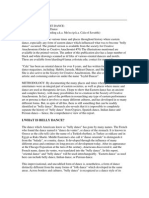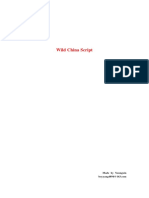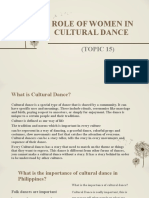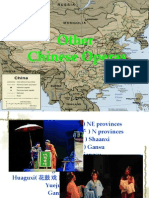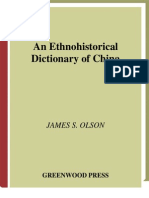Dragon Dance Lion Dance Ethnic Groups in China
Dragon Dance Lion Dance Ethnic Groups in China
Uploaded by
layzierainCopyright:
Available Formats
Dragon Dance Lion Dance Ethnic Groups in China
Dragon Dance Lion Dance Ethnic Groups in China
Uploaded by
layzierainOriginal Description:
Original Title
Copyright
Available Formats
Share this document
Did you find this document useful?
Is this content inappropriate?
Copyright:
Available Formats
Dragon Dance Lion Dance Ethnic Groups in China
Dragon Dance Lion Dance Ethnic Groups in China
Uploaded by
layzierainCopyright:
Available Formats
Dance in China
China has a long recorded history of various dance forms. Some Chinese dances such as dancing with long sleeves have been recorded for a long time. The best known Chinese dances nowadays are the Dragon dance and the Lion Dance. There are also 56 officially recognized ethnic groups in China, and each ethnic minority group in China also has its own folk dances.
Early history mime or burlesque jugglers, but there are other suggestions.[60] Folk dances of Han Chinese
Representations of dance have been found in Chinese pottery as early as the Neolithic period where groups of people are depicted dancing in a line holding hands.[1] The earliest Chinese word for "dance" written in the oracle bones is the character , a representation of a dancer holding oxtails in each hand performing an ancient dance.[2] According to the Lshi Chunqiu: "In former times, the people of the Getian clan () would dance in pairs [or threes] with oxtails in hand, stamping their feet and singing eight stanzas."[3][4] Primitive dance in ancient China was also associated with sorcery and shamanic rituals. An early shape of the Chinese character for sorcerer, wu (), represented dancing shamans or their sleeves;[5] wu therefore described someone who danced as a mean of communication between gods and men,[6] There are many mentions of dances by shamans and sorcerers in ancient records, for example, the performance of rain dance at times of drought.
Many of the folk dances are related to harvest and hunting and the ancient gods associated with them. For example, the Constellation Dance was performed to procure as much seed grain as there are stars in the sky, while the Harpoon Dance was associated to Fuxi who according the mythology gave the Han people fish net, and the Plough Dance was connected to Shennong, the god of agriculture.[61] Some examples of Chinese folk dance
Yangge - a dance that is common in Northern China. Lantern Dance - a dance found in Southern China. Er Ren Zhuan
Folk dances of ethnic minorities in China
There are many minority groups in China and each have their own dances that reflect their culture and way of life.[62] A few examples of their dances:
Traditional dance
Dragon dance - there are more than 700 different dragon dances in China Lion dance - the earliest detailed description of Lion Dance appeared during the Tang Dynasty, but it may have reached China as early as the third century AD.[29] One suggestion of its origin is that the dance was introduced from India by
Baishou Dance - a dance of the Tujia people Mongolian Bowl Dance () - a dance where female dancers balance several bowls on their heads while dancing. Long Drum Dance () - a dance of the Yao people which inspired the orchestral composition Dance of the Yao People. Sanam - an Uyghur dance. Lhamo - a Tibetan opera with dancing and singing
Ritual dance
Most early records of dances in China were ritual or ceremonial dances, and they were considered to be of great importance. These dances have largely disappeared from modern Han Chinese culture, although ritual dances are still found in the some folk traditions and the cultures of ethnic minorities in China.
Yi Dance (, literally "row dance") was originally a court dance, but adopted to form part of a Confucian ceremony. This is performed with rows of dancers holding pheasant feathers and red flutes in a square formation, and the most important ceremony is performed with 8 rows of 8 dancers (the Eight Yi Dance, 64 dancers in all). Previously dances were only performed in 6 rows of dancers (36 dancers in all) in Confucian temples as 8 rows were restricted to the Imperial court,[63][64] but permission was granted later by an emperor to perform the 8-row dance as well. Modernized version of such performances are presented for tourists at the confucian temple in Qufu.[65] This confucian dance is also performed in Taiwan and Korea. Nuo Dances () - a dance with masks which may be performed in Nuo opera or as rituals during festivals to drive away evil spirits.[66] Cham dance - a Tibetan Buddhist dance
Dragon dance
Folk dance from a minority group of china
Exercise dance
According to Lshi Chunqiu, during the time of Emperor Yao, a dance was created as exercise for the people to keep healthy after a prolonged spell of wet weather.[67] Traditionally some Chinese dances may also have connection with the martial arts and used to train fighting skills as well as for fitness, and some martial art exercises are similar to a choreographed dance. In modern China, older people may also use dance as a form of exercise in parks.
Chinese fan dance
Some Chinese dances
Ribbon dance
You might also like
- Tao Teh Ching by DC LauDocument37 pagesTao Teh Ching by DC LauNeil LubinNo ratings yet
- Pe 206 Philippione Folkdance v2 HandoutsDocument41 pagesPe 206 Philippione Folkdance v2 HandoutsMillias Ikarrio NaveNo ratings yet
- The Beauty of Polynesian DanceeDocument4 pagesThe Beauty of Polynesian Danceeapi-287797799100% (1)
- Chapter 3.the Concept of Korean Folk Dance1Document32 pagesChapter 3.the Concept of Korean Folk Dance1Jared RedmondNo ratings yet
- Pe 2Document5 pagesPe 2Paopao MacalaladNo ratings yet
- List of All The Martial Arts in The WorldDocument191 pagesList of All The Martial Arts in The WorldSamurai_Chef83% (6)
- A New Practical Primer of Literary Chinese Unit 4Document53 pagesA New Practical Primer of Literary Chinese Unit 4literarychNo ratings yet
- Delegate List: Name Position Organisation CountryDocument14 pagesDelegate List: Name Position Organisation CountryAnonymous dIK4xERP100% (1)
- History of DanceDocument7 pagesHistory of Dances_bishoymagdyfekryNo ratings yet
- Dance in ChinaDocument5 pagesDance in ChinaTrixie Nichole Garaña EspejoNo ratings yet
- History of Dance: Means of Social Communication and BondingDocument2 pagesHistory of Dance: Means of Social Communication and BondingjvNo ratings yet
- Dances in AsiaDocument9 pagesDances in Asiasheryl ♥100% (1)
- Brief Introduction To Classical Dance FormsDocument4 pagesBrief Introduction To Classical Dance FormsKiranmai BonalaNo ratings yet
- Historia de La Danza Oriental (Ingles)Document39 pagesHistoria de La Danza Oriental (Ingles)haydeeoram75% (4)
- Istoria DansuluiDocument15 pagesIstoria DansuluiLydia GeorgetaNo ratings yet
- PE 12 Lesson 1 and 2Document41 pagesPE 12 Lesson 1 and 2jecelle.kyla.sarmiento03No ratings yet
- Dansuri - Indiene - in EnglezaDocument20 pagesDansuri - Indiene - in EnglezaMikey ElaNo ratings yet
- Text 9 History of The Armenian DanceDocument7 pagesText 9 History of The Armenian DanceMonicaMartirosyanNo ratings yet
- Wild China Script: Made by YoungxinDocument55 pagesWild China Script: Made by Youngxinlast to knowNo ratings yet
- International Folk DanceDocument9 pagesInternational Folk Danceciantal batobato0% (1)
- Folk DanceDocument6 pagesFolk DanceNeanderthalNo ratings yet
- Arts of China: EssayDocument11 pagesArts of China: Essay....No ratings yet
- Dance 101Document17 pagesDance 101Carl Jay TenajerosNo ratings yet
- The Role of Women in Cultural Dance.Document15 pagesThe Role of Women in Cultural Dance.Reyannah Jane VillariezNo ratings yet
- Full History of DanceDocument13 pagesFull History of Dancegian lloydNo ratings yet
- The Ritual Origins of The Classical Dance Drama of CambodiaDocument26 pagesThe Ritual Origins of The Classical Dance Drama of CambodiaSedge100% (1)
- Chinese OperasDocument10 pagesChinese Operasapi-3820627No ratings yet
- Apsara DanceDocument4 pagesApsara DancePhirun RaNo ratings yet
- Folk Dance: Tallinn UniversityDocument16 pagesFolk Dance: Tallinn UniversityMark Nathaniel AytinNo ratings yet
- Notes - History of DanceDocument3 pagesNotes - History of DanceJullieNo ratings yet
- Music of South Asia and Middle East (India and Israel)Document50 pagesMusic of South Asia and Middle East (India and Israel)CATANE, Nehemiah ShifrahNo ratings yet
- Writing and Performing The Trinity of OdissiDocument11 pagesWriting and Performing The Trinity of Odissisingingdrum100% (1)
- History of DanceDocument20 pagesHistory of Dancejoel BelzaNo ratings yet
- An Ethnohistorical Dictionary ChinaDocument446 pagesAn Ethnohistorical Dictionary Chinawasi_budiarto100% (1)
- Brief History of DanceDocument2 pagesBrief History of DanceKent GallardoNo ratings yet
- Chinese LiteratureDocument20 pagesChinese LiteraturePasia Esmedilla JennyNo ratings yet
- Ancient Chinese CivilizationDocument30 pagesAncient Chinese CivilizationAJNo ratings yet
- Uyghurs: 1 Name 2 IdentityDocument24 pagesUyghurs: 1 Name 2 Identitydavid zerpaNo ratings yet
- Fairs and FestivalsDocument4 pagesFairs and FestivalsAman Deep KaurNo ratings yet
- History of DanceDocument14 pagesHistory of DanceAiza SanchezNo ratings yet
- Indian Classical DancesDocument8 pagesIndian Classical DancesSamyak MohantyNo ratings yet
- Buddhism, PaxKushana and Greco Roman Motifs PDFDocument11 pagesBuddhism, PaxKushana and Greco Roman Motifs PDFJan PospíšilNo ratings yet
- Folk DanceDocument5 pagesFolk DanceronaldocuetoNo ratings yet
- Aharya Abhinaya Makeup Chhau DanceDocument15 pagesAharya Abhinaya Makeup Chhau DancePavithra ManjunathNo ratings yet
- Clan Association - LectureDocument67 pagesClan Association - LectureHuiqing KhongNo ratings yet
- Korean Buddhist Dances, ClassificationDocument4 pagesKorean Buddhist Dances, ClassificationnutziiNo ratings yet
- Art of ChinaDocument70 pagesArt of ChinaChandan KumarNo ratings yet
- Anca Giurchescu Power of Dance Anthropology of DanceDocument16 pagesAnca Giurchescu Power of Dance Anthropology of DanceRomario Patogian100% (1)
- PEDocument12 pagesPEMarjhun LaguillesNo ratings yet
- The Roles of Lao Buddhist Sa Gha On Applied Social Work in Lao SocietyDocument9 pagesThe Roles of Lao Buddhist Sa Gha On Applied Social Work in Lao SocietyສຽງທັມVOICENo ratings yet
- Shang DynastyDocument13 pagesShang DynastyEneaGjonajNo ratings yet
- Creative DancesDocument1 pageCreative DancesEljoy AgsamosamNo ratings yet
- MenoraDocument6 pagesMenoraanon-604041100% (2)
- Kaeppler - ETNOCOREOLOGIADocument5 pagesKaeppler - ETNOCOREOLOGIAMădălina OprescuNo ratings yet
- Module 1: Folk Dancing: P.E. IiDocument11 pagesModule 1: Folk Dancing: P.E. IiJan Jerwin PobleteNo ratings yet
- 12 Popular Types of DanceDocument5 pages12 Popular Types of DanceHasz RonquilloNo ratings yet
- Philippine Folk DanceDocument17 pagesPhilippine Folk Danceiohannes_zamoraNo ratings yet
- 16th Century Dance From Khorasan by Lady Vashti Al-AsarDocument20 pages16th Century Dance From Khorasan by Lady Vashti Al-AsarFalconBannerNo ratings yet
- Divine Dance OdissiDocument6 pagesDivine Dance OdissijffjfvvhNo ratings yet
- Kurath, G P - Panorama of Dance EthnologyDocument23 pagesKurath, G P - Panorama of Dance EthnologyDanielle LimaNo ratings yet
- Module in PE2 Introduction To DanceDocument21 pagesModule in PE2 Introduction To DanceDaisy QuizadaNo ratings yet
- Assessment 2Document4 pagesAssessment 2Wilma Rose RiveraNo ratings yet
- Chinese Theater 2323Document4 pagesChinese Theater 2323⎝⏠⏝⏠⎠ Mohd Zaidi IsmailNo ratings yet
- 1941-陈荣捷-Lao Tzu's the Tao and Its Virtue by John C. H. Wu and Lao TzuDocument2 pages1941-陈荣捷-Lao Tzu's the Tao and Its Virtue by John C. H. Wu and Lao TzuJoey LNo ratings yet
- Twin LotusDocument77 pagesTwin LotusEkkaphon JoeNo ratings yet
- Timetable: The 9th Asian Rock Mechanics Symposium (ARMS9) The Stones Hotel, Bali - Indonesia, 18 - 20 October 2016Document1 pageTimetable: The 9th Asian Rock Mechanics Symposium (ARMS9) The Stones Hotel, Bali - Indonesia, 18 - 20 October 2016Salam Daeng BengoNo ratings yet
- Grade 7 Term 1 Usst - Revision 1Document2 pagesGrade 7 Term 1 Usst - Revision 1Vidya AneeshNo ratings yet
- Richard Rutt Vol049Document86 pagesRichard Rutt Vol049Lex ElefAntNo ratings yet
- Uncovering The Myths of Two 19th-Century Hokkien Business Personalities in The Straits SettlementsDocument11 pagesUncovering The Myths of Two 19th-Century Hokkien Business Personalities in The Straits SettlementsMohamad Fazwan Bin Mohd NasirNo ratings yet
- đề 12Document6 pagesđề 12Nguyễn Đức BáchNo ratings yet
- Taoism and EcologyDocument22 pagesTaoism and Ecologysorbciren10No ratings yet
- Rune JeraDocument28 pagesRune Jeranikos nevrosNo ratings yet
- Korean CultureDocument17 pagesKorean CultureAhMaoFung100% (1)
- Age of Exploration: China Limits European ContactsDocument21 pagesAge of Exploration: China Limits European ContactsPol BarrigaNo ratings yet
- ShizenDocument64 pagesShizenMario Cesar de Oliveira100% (3)
- 1Document17 pages1Jaromohom AngelaNo ratings yet
- Code GTA San AndreasDocument6 pagesCode GTA San AndreasKhaled AmalurNo ratings yet
- 233 An Introduction To The Chinese School Eco-TranslatologyDocument16 pages233 An Introduction To The Chinese School Eco-TranslatologyLeidy R Jiménez100% (1)
- Chinese Phrase BookDocument5 pagesChinese Phrase BookgbsimpsaNo ratings yet
- Chapter 12 - Reunification and Renaissance in Chinese Civilization: in The Era of The Tang and Song Dynasties C. Focus QuestionsDocument2 pagesChapter 12 - Reunification and Renaissance in Chinese Civilization: in The Era of The Tang and Song Dynasties C. Focus QuestionsstillnotbeaNo ratings yet
- Greatest Love Teachings Announcement (Master Sha's US Team)Document9 pagesGreatest Love Teachings Announcement (Master Sha's US Team)Laxmi AbundanceNo ratings yet
- Logbook Ece 4992Document1 pageLogbook Ece 4992JakeWilliamNo ratings yet
- CONFUCIANISM AssessmentDocument2 pagesCONFUCIANISM AssessmentPark Lin MariNo ratings yet
- Yi Jin JingDocument2 pagesYi Jin JingRoger Juntunen100% (1)
- South KoreaDocument3 pagesSouth Koreaapi-272744559No ratings yet
- SSL Swim Meet Results Day1Document24 pagesSSL Swim Meet Results Day1api-339483574No ratings yet
- Namelist 2017 05.03.17Document42 pagesNamelist 2017 05.03.17Tang Lih FangNo ratings yet
- Five Elements IntroDocument14 pagesFive Elements IntroLinda Marlene EalesNo ratings yet
- World Religions - Q2 - Module 12Document11 pagesWorld Religions - Q2 - Module 12Ira Jane CaballeroNo ratings yet













